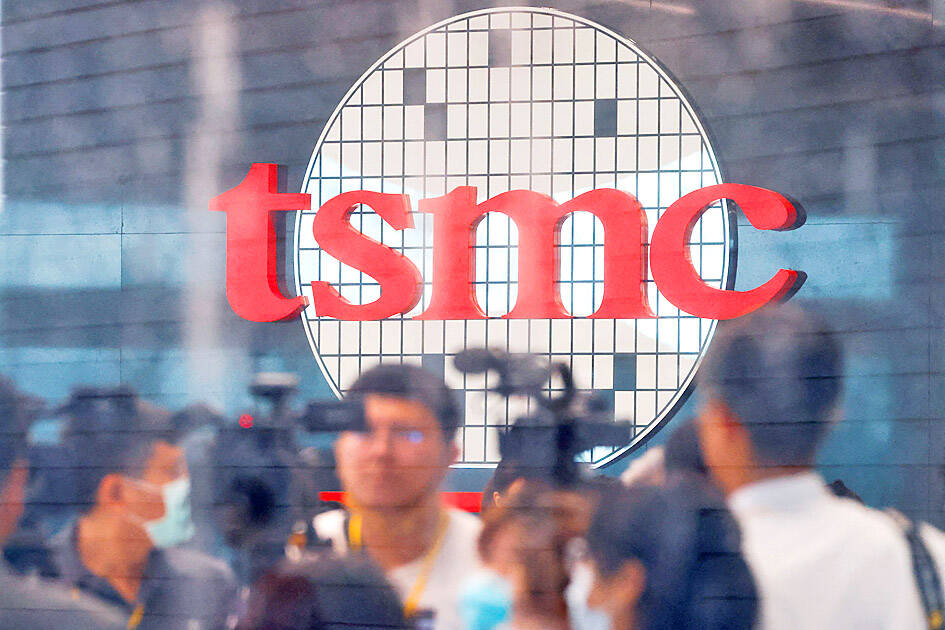Taiwan Semiconductor Manufacturing Co (TSMC, 台積電) yesterday said it has dropped a plan to build a new fab to produce next-generation chips in the Longtan (龍潭) section of Hsinchu Science Park (新竹科學園區) amid local protests over government appropriation of privately owned land for industrial use.
TSMC issued a statement after a self-help group representing some residents of Longtan in Taoyuan, said on Facebook that the world’s biggest contract chipmaker had dropped its new fab construction plan in Longtan after negotiations broke down on Friday.
TSMC had planned to build a factory in Longtan to produce 1.4-nanometer chips, which would be its most advanced chips. Its 2-nanometer chips are scheduled to be available in 2025 and its 3-nanometer chips are already being used in Apple Inc’s latest iPhone 15 series.

Photo: Ann Wang, Reuters
“After evaluation, TSMC is no longer considering establishing a site at phase 3 of the Longtan section under present conditions,” the chipmaker said in a statement.
“TSMC will continue working with the Science Park Administration to evaluate land in Taiwan suitable for building semiconductor fabs,” it said.
It said that it is a tenant leasing land from the science park, while the government is responsible for science park planning.
“TSMC respects the local community and regulatory authorities, and we do not have further comment on land appropriation,” the chipmaker said.
The phase 3 expansion project in the Longtan section of the park would cover 158.59 hectares, about 90 percent of which is privately owned.
Since the expansion project was unveiled in December last year, it has sparked discontent among local residents.
The self-help group has protested the government’s plan to appropriate land.
The group yesterday asked the Hsinchu Science Park Administration to scrap the land appropriation plan entirely, as TSMC would no longer be building its fab in Longtan.
The Ministry of Economic Affairs said that it would help TSMC to find a new location for the fab, as the chipmaker has made it clear that a majority of its capacity would be based in Taiwan and its most advanced chips would be built here, Minister of Economic Affairs Wang Mei-hua (王美花) said.
TSMC told investors early this year that it expected overseas capacity to make up about 20 percent of its total capacity for 28-nanometer and less advanced chips in five years’ time.
The chipmaker is building two advanced factories in Arizona to make 4-nanometer and 3-nanometer chips, while its factories in Japan and Germany are to produce 28-nanometer and 16-nanometer chips to satisfy local demand for automotive chips.

Conflict with Taiwan could leave China with “massive economic disruption, catastrophic military losses, significant social unrest, and devastating sanctions,” a US think tank said in a report released on Monday. The German Marshall Fund released a report titled If China Attacks Taiwan: The Consequences for China of “Minor Conflict” and “Major War” Scenarios. The report details the “massive” economic, military, social and international costs to China in the event of a minor conflict or major war with Taiwan, estimating that the Chinese People’s Liberation Army (PLA) could sustain losses of more than half of its active-duty ground forces, including 100,000 troops. Understanding Chinese

The Ministry of Foreign Affairs (MOFA) yesterday said it is closely monitoring developments in Venezuela, and would continue to cooperate with democratic allies and work together for regional and global security, stability, and prosperity. The remarks came after the US on Saturday launched a series of airstrikes in Venezuela and kidnapped Venezuelan President Nicolas Maduro, who was later flown to New York along with his wife. The pair face US charges related to drug trafficking and alleged cooperation with gangs designated as terrorist organizations. Maduro has denied the allegations. The ministry said that it is closely monitoring the political and economic situation

UNRELENTING: China attempted cyberattacks on Taiwan’s critical infrastructure 2.63 million times per day last year, up from 1.23 million in 2023, the NSB said China’s cyberarmy has long engaged in cyberattacks against Taiwan’s critical infrastructure, employing diverse and evolving tactics, the National Security Bureau (NSB) said yesterday, adding that cyberattacks on critical energy infrastructure last year increased 10-fold compared with the previous year. The NSB yesterday released a report titled Analysis on China’s Cyber Threats to Taiwan’s Critical Infrastructure in 2025, outlining the number of cyberattacks, major tactics and hacker groups. Taiwan’s national intelligence community identified a large number of cybersecurity incidents last year, the bureau said in a statement. China’s cyberarmy last year launched an average of 2.63 million intrusion attempts per day targeting Taiwan’s critical

‘SLICING METHOD’: In the event of a blockade, the China Coast Guard would intercept Taiwanese ships while its navy would seek to deter foreign intervention China’s military drills around Taiwan this week signaled potential strategies to cut the nation off from energy supplies and foreign military assistance, a US think tank report said. The Chinese People’s Liberation Army (PLA) conducted what it called “Justice Mission 2025” exercises from Monday to Tuesday in five maritime zones and airspace around Taiwan, calling them a warning to “Taiwanese independence” forces. In a report released on Wednesday, the Institute for the Study of War said the exercises effectively simulated blocking shipping routes to major port cities, including Kaohsiung, Keelung and Hualien. Taiwan would be highly vulnerable under such a blockade, because it